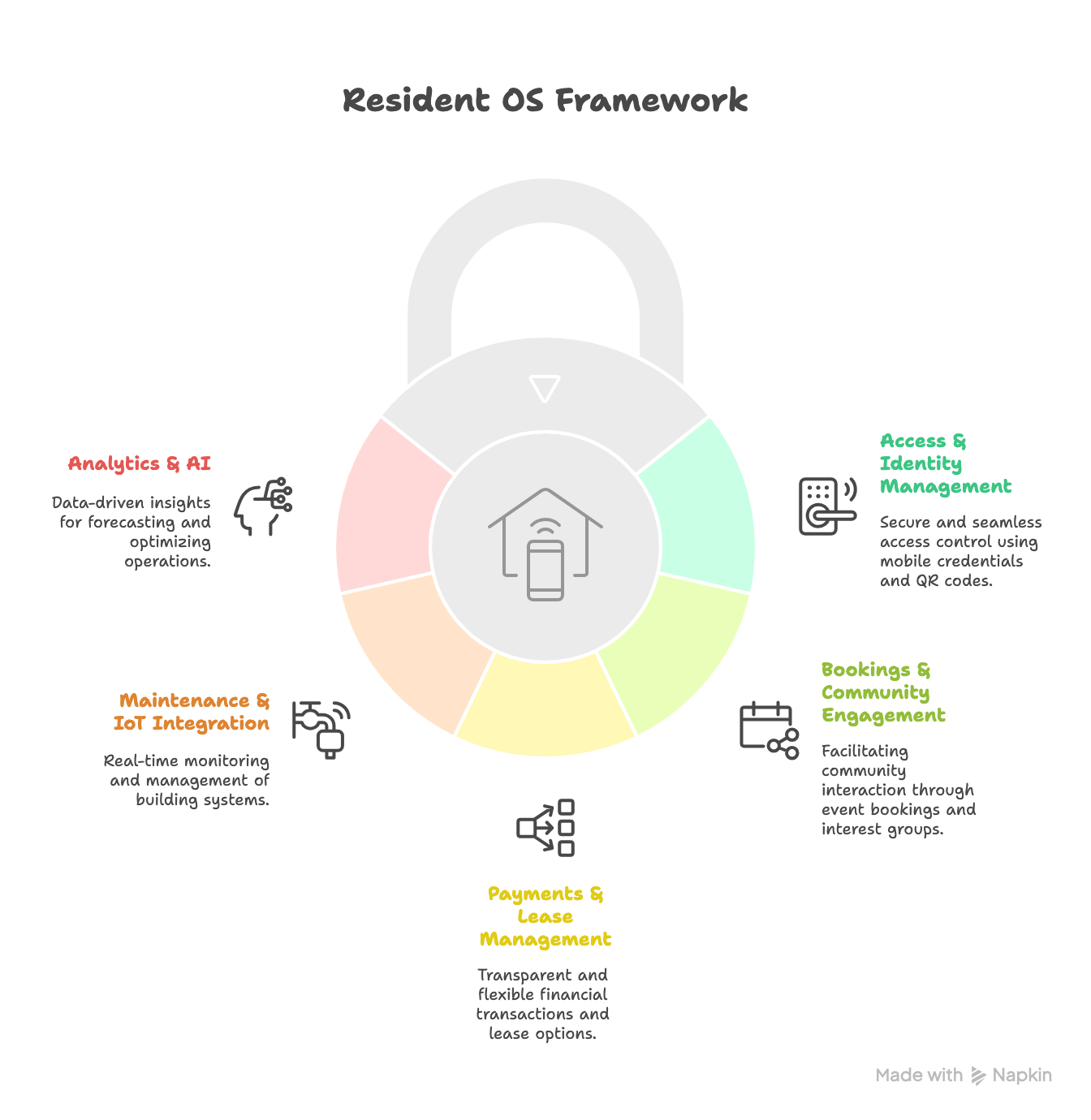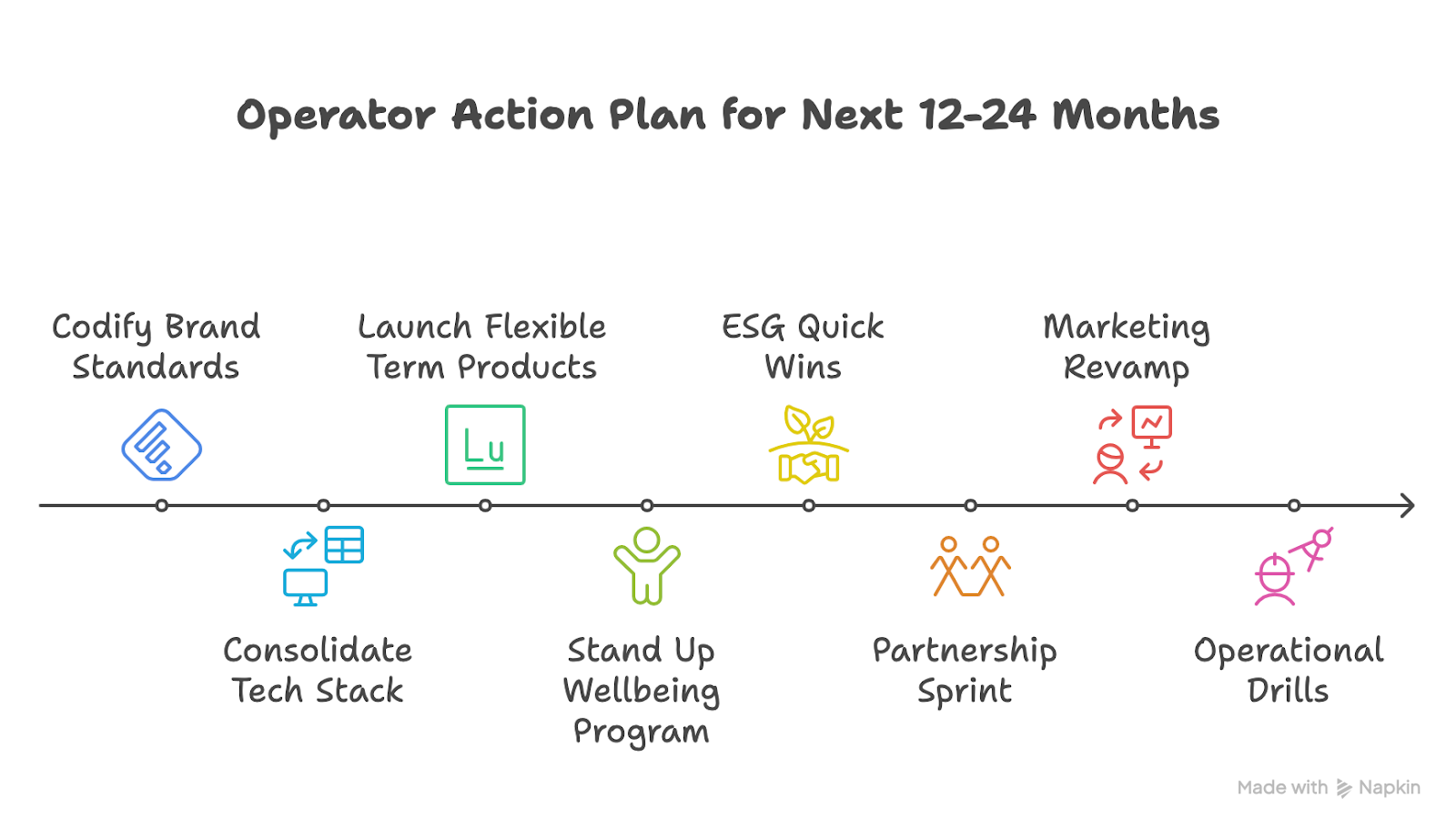Co-living and purpose-built student accommodation (PBSA) are no longer niche assets—they’re fast-maturing, operationally intensive real-estate platforms shaped by shifting demographics, affordability gaps, hybrid learning/work, and resident expectations for hospitality-grade service.
For operators, owners, and developers, the next five years will reward those who treat these assets like living, data-driven ecosystems rather than static buildings. This guide distills where the sector is heading and the practical moves operators need now.
Market Outlook: From Beds to Experience Platforms
Demand tailwinds remain robust: urbanization among Gen Z/Gen Alpha, international student mobility, delayed household formation, and the rise of remote/hybrid work. Meanwhile, constrained supply in gateway and university cities creates structural occupancy resilience. The future competitive edge will come from experience density—the bundle of community, programming, digital services, safety, and flexibility wrapped around the bedroom.
Operator takeaways
- Plan for stable high occupancy but more price sensitivity—optimize yield through flexible contract lengths and tiered amenities.
- Treat your portfolio as a service network: residents expect seamless transfers, consistent brand standards, and shared digital entitlements across locations.
- Build partnerships with universities, employers, and study-abroad providers to lock in bulk demand.
Product Design 2.0: Space That Works Harder (and Smarter)
The co-living and student housing models of the future demand more than just beds and shared kitchens. Tomorrow’s winners will be those who create environments that balance privacy, productivity, and community, where micro-private spaces and macro-shared spaces plug together like LEGO pieces. Design decisions today must anticipate how residents will study, work, relax, and build community tomorrow.
Below are the core design shifts operators must prioritize to deliver environments that truly align with how Gen Z lives, studies, and connects.
Right-Sized Private Spaces
Private living areas should be designed as mini sanctuaries that still work hard for residents. Operators should consider acoustically robust rooms with STC 55+ walls to minimize noise bleed, ensuring residents can study, rest, and attend online classes or remote work meetings without interruption. Built-in desks with monitor arms and ergonomic seating provide an immediate workspace, while blackout shades and true HVAC zoning ensure comfort and sleep quality. The aim is to maximize utility in a small footprint, offering everything a resident needs without compromising privacy or wellness.
Programmed Shared Zones
On the other end of the spectrum, shared zones must deliver variety and function. These aren’t just lounges anymore—they are carefully programmed environments where residents can collaborate, innovate, and recharge. Think makerspaces with 3D printers, bookable focus pods for uninterrupted work, podcast booths for content creators, meditation rooms for wellness, and micro-venues for student clubs or community meetups. Commercial-grade kitchens should be standard, designed to handle both daily cooking and larger group events. By programming these shared zones, operators give residents value that extends far beyond a dormitory or apartment rental.
Modular FF&E for Flexibility
Furniture and fixtures can no longer be static. Modern student and co-living spaces must adopt modular furniture and demountable partitions that transform spaces on demand. Imagine a study hall by day that converts into a social lounge by night—all with movable walls, foldable tables, and seating on casters. This flexibility reduces long-term capex while keeping spaces relevant to residents’ shifting needs.
Safety by Design
Security is not just about locks and cameras—it must be built into the design. Applying CPTED (Crime Prevention Through Environmental Design) principles ensures clear sightlines, layered access control, and environments that feel safe and inclusive. Bathroom layouts should feature gender-inclusive cubicles with enhanced privacy, making spaces more welcoming to diverse residents. Safety must be intuitive, not obtrusive.
Sustainability Baked In
Future-forward design must also be sustainability-first. Operators should integrate heat-pump hot water systems, induction cooktops, solar-ready roofs, greywater recycling (where regulations allow), and low-VOC materials to create healthier, more efficient buildings. This not only lowers operational costs but also appeals to environmentally conscious Gen Z and Millennial residents who value eco-friendly living.
Digital Backbone: From Access Control to Resident OS
Today’s residents expect housing that functions like a tech-enabled lifestyle hub. The housing provider’s digital infrastructure must go beyond Wi-Fi and card access—it should act as a Resident Operating System (Resident OS) that simplifies life administration, drives engagement, and integrates all building operations under one pane of glass.
The following elements outline how operators can build a digital-first ecosystem that enhances daily living, streamlines operations, and deepens resident engagement.
Access & Identity Management
Access systems should be seamless yet secure, with mobile credentials, visitor QR codes, and device-level revocation capabilities. This allows residents to manage access for themselves and guests easily, while operators maintain full control of security.
Bookings & Community Engagement
The digital stack should enable residents to reserve rooms, pods, or event spaces directly from an app. Integrated calendars can showcase community events, workshops, or club activities, while in-app peer-to-peer interest groups and skill exchanges foster authentic connections among residents.
Payments & Lease Management
Financial transactions should be transparent and flexible. Systems must handle prorated billing, deposit alternatives (such as insurance-backed deposits), instant refunds on vacancy, and lease flexibility ranging from 4-week stays to year-long contracts. Giving residents choice builds trust and improves occupancy rates.
Maintenance & IoT Integration
IoT-enabled systems should provide real-time monitoring of HVAC, water, and electrical systems. Leak sensors, smart meters per floor, and uptime dashboards give operators early fault detection while reducing repair costs. Residents benefit from a more reliable living environment, while staff spend less time firefighting.
Analytics & AI
A true Resident OS uses data not just for operations but also for forecasting demand, dynamic pricing, and churn prediction. AI-driven tools can handle resident FAQs, triage maintenance requests, perform sentiment analysis from reviews/surveys, and even optimize workforce scheduling.

Revenue Strategy: Yield Management Without Alienating Residents
In a climate of rising costs and financial pressures, revenue optimization in co-living and student housing must strike a balance between profitability and fairness. Operators who are transparent and thoughtful in their monetization strategies will maintain trust while driving higher yield.
These strategies show how operators can optimize yield without undermining the resident experience, ensuring financial sustainability while keeping community at the center:
Tiered Room Types
Not all rooms are created equal—and they shouldn’t be priced as such. Offering ensuite units, shared-bath units, premium corner rooms, and high-view apartments establishes a clear value ladder. Transparency about what each option includes prevents residents from feeling overcharged.
Flexible Length-of-Stay Pricing
Operators should build conversion incentives into stay lengths. Weekly, semester-based, and annual pricing can appeal to different resident types, from exchange students to long-term interns. Discounts for committing to longer stays encourage retention while providing stability to operators.
Ancillary Revenue Done Right
Residents don’t mind paying extra—as long as they see clear value. Instead of hidden “junk fees,” operators should focus on optional paid services such as printing credits, bike/e-scooter storage, premium bandwidth, cleaning bundles, or micro-storage units. Transparency is key: residents should know exactly what they’re paying for.
Community Programming
Well-designed community programming can itself become a revenue stream. Paid workshops on coding, certifications, language exchanges, and even sponsored networking events can both enrich the resident experience and generate additional income. When community-building aligns with revenue, everyone wins.
Corporate and Educational Partnerships
Partnerships with universities, corporations, and institutions provide stable block bookings. Intern housing, graduate programs, and visiting scholar residencies offer operators predictable occupancy while also expanding brand credibility. These partnerships are an increasingly critical part of sustainable yield management.
Community & Wellbeing: Hospitality Standards for Gen Z
Community is the moat—and mental health sits at its center. For Gen Z, co-living and student housing is not just about a bed and four walls, but about feeling seen, supported, and connected in an environment that balances independence with togetherness. Operators who can foster authentic communities while embedding wellness into the resident experience will set themselves apart.
The next wave of housing must meet Gen Z’s expectation for safe, inclusive, and engaging spaces that nurture both social bonds and personal wellbeing. To achieve this, operators can design their models around core pillars that serve as the foundation for a thriving resident experience:
- Belonging
A sense of belonging is non-negotiable. Residents are more likely to thrive when they feel part of a community that shares their values and interests. Operators should create structured opportunities for peer-to-peer connection, such as resident ambassadors, peer mentors, or community leads who serve as go-to resources. Themed living communities (STEM, arts, entrepreneurship, sustainability) allow students to self-select into groups where shared passions make social integration easier and more organic. Digital platforms can extend this sense of belonging beyond the physical building, with interest-based forums, group chats, and shared projects.
- Wellness
Wellbeing programs must go beyond token gestures—Gen Z expects proactive, evidence-based support. Quiet hours policies, meditation rooms, and light-touch check-ins during high-stress periods (like midterms and finals) signal that operators genuinely care about resident health. Structured programming around sleep hygiene, financial literacy, nutrition, and stress management can have an outsized impact on academic and personal success. Bringing in local wellness practitioners or offering app-based wellness partnerships (like therapy discounts or fitness subscriptions) also adds value while destigmatizing mental health support.
- Safety & Inclusion
Safety is both physical and psychological. Operators need staff trained in de-escalation techniques and cultural competence to ensure residents feel protected and respected. Clear reporting channels for harassment or misconduct, combined with visible policies on inclusivity, help create an environment of trust. Gender-inclusive facilities and layouts that prioritize privacy—such as bathroom cubicles with floor-to-ceiling partitions—are now considered baseline expectations. Representation in staff and programming also ensures that diverse resident groups feel valued and heard.
- Activation Calendar
Events are not filler—they are the social glue. A strong activation calendar should mix casual, low-lift weekly gatherings like board games, potlucks, or coffee chats with monthly signature events co-hosted with local partners, clubs, or alumni. Workshops that blend fun with skill-building—like cooking classes, startup pitch nights, or cultural exchange dinners—help residents feel both engaged and enriched. Flexibility is key: events should accommodate introverts and extroverts alike, offering both intimate circles for deeper connections and larger gatherings that foster broad community spirit.
Operations: Lean, Safe, and Scalable
Operational excellence means happier residents and lower costs per bed. A hybrid staffing model works best—centralized operations handle efficiency, while on-site community teams maintain human connection. Staff should be cross-trained to cover front desk support, event management, and basic triage.
Service-level agreements (SLAs) keep expectations clear: urgent repairs in under 4 hours, standard ones within 48. Procurement should balance national contracts for consistency with local vendor networks for emergencies. Crisis readiness is non-negotiable—operators need playbooks for outages, leaks, cyber risks, and health events, with regular drills to ensure preparedness. Efficient turnover practices—like QR-tagged checklists, standardized kits, and logistics for quick move-outs—help maximize occupancy without compromising quality.
Compliance & Risk: Getting Ahead of the Rules
Regulations are tightening across fire safety, accessibility, privacy, and leasing transparency. Proactive compliance can be a brand advantage. Annual life-safety audits and third-party inspections should be standard. Accessibility should go beyond minimum codes, with wheelchair-first layouts, tactile signage, and neurodiverse-friendly design.
Privacy by design builds trust—data retention limits, clear consent management, and strong breach response protocols must be in place. Lease terms should be plain-English, outlining “what’s included” and ensuring transparent rent and deposit handling. Operators that stay ahead of regulations reduce liability while building long-term trust with both residents and institutions.
Partnerships That Matter: Universities, Employers, Cities
Strong partnerships stabilize demand and elevate reputation. Universities can provide priority housing lists, referral pipelines, and even shared staffing through RA programs, while bundled credits for meals or printing integrate housing into student life.
Employers are seeking housing solutions for interns, graduates, and workforce pilots—blocks of units tied to shuttle services or commuting incentives can meet this need. Cities also matter, particularly when housing aligns with local priorities: affordable set-asides, inclusive neighborhood programming, and local hiring help operators win political goodwill and long-term approvals.
KPIs That Matter: Run the Portfolio Like a Product
A successful housing operator treats the portfolio like a product, tracking KPIs that balance resident wellbeing with financial health. Leasing performance should track pre-lease percentages, cost per lease, and conversion rates. Operational metrics like work-order completion and system uptime highlight efficiency, while unit turn times affect occupancy rates.
Resident health goes beyond NPS—event participation, renewal intent, and incident rates provide a real pulse on community wellbeing. Financials should be normalized per bed (NOI, ancillary revenue, utilities), while ESG measures like energy use, water, waste diversion, and indoor air quality signal long-term responsibility. Transparency in sharing these metrics builds trust with residents, universities, and investors alike.
Playbook for the Next 12–24 Months: Operator Action Plan
The student housing and co-living sector is evolving rapidly, requiring operators to balance hospitality, technology, wellbeing, and sustainability. To stay ahead, operators need a clear roadmap that aligns brand standards, partnerships, and resident experience with long-term growth. Below is a strategic action plan for the next 12–24 months, summarized in an easy-to-follow infographic.

Community, Flexibility, and Intelligence Will Win
The future of co-living and student housing belongs to operators who blend hospitality, technology, and purpose. Build privacy that respects study and sleep, community that drives belonging, digital rails that remove friction, and ESG that lowers costs while doing right by residents and cities.
If you operate like a modern service platform—data-literate, partnership-minded, and resident-obsessed—you won’t just fill beds; you’ll build durable, scalable brands.
Ready to future-proof your student housing or co-living operations? Booking Ninjas helps operators streamline property management, centralize data, and enhance the resident experience with intelligent automation. Connect with us today to see how we can power your growth.







_-_A_Complete_Guide.png)











+for+Hotel+Chains.png)